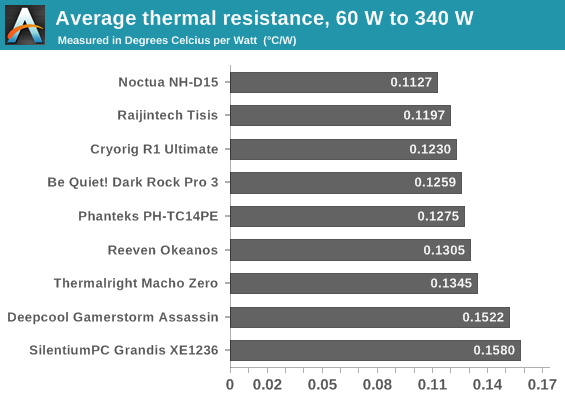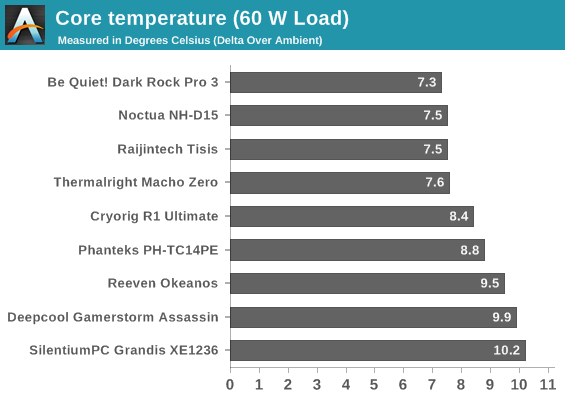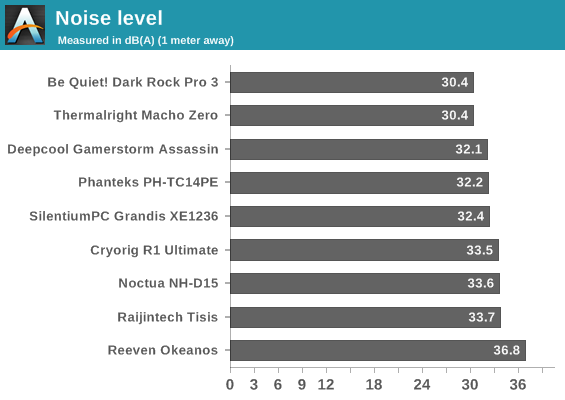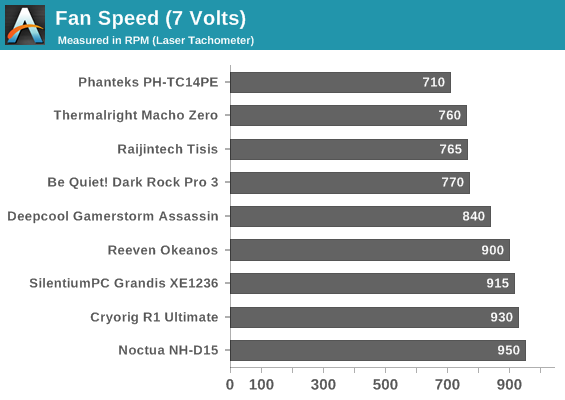Top Tier CPU Air Coolers Q3 2015: 9-Way Roundup Review
by E. Fylladitakis on July 6, 2015 8:00 AM ESTTesting results, low fan speed (7 Volts)


| Core Temperature, Constant Thermal Load |
|
|


*Note: When the cooler has two different fans, the fan speed of the faster fan is recorded.
**Note: Some of this review's PWM fans will not start if simply powered from a 7 Volts power source. Electronic supervision is required to start the fan and then reduce the voltage down to 7 Volts, or a PWM source.
Reducing the fan voltage down to 7 Volts shifts the thermal performance charts a little but brings all of the coolers down to virtually inaudible levels. The sole exception is the Okeanos, which definitely improved vastly in comparison to having its fans running at maximum speed, but remains audible.
With the Okeanos losing its advantage of brute force, the Noctua NH-D15 and the Raijintek Tisis now lead the thermal performance charts, closely followed by Cryorig's R1 Ultimate. The Phanteks PH-TC14PE is a bit more complicated, displaying that it can do much better at lower loads than with high loads, hinting that the airflow of the fans is simply not enough for this design to cope with very high loads. Be Quiet!'s Dark Rock Pro 3 is now showing thermal performance comparable to that of the aforementioned coolers, especially when the thermal load is low. Still, the Dark Rock Pro 3 technically loses its acoustics performance advantage. It may be dead-silent, with our equipment unable to record anything about the room's noise floor level, but the rest of the coolers are virtually inaudible as well.
The Thermalright Macho Zero is at advantage in these tests, as the cooler is optimized for low airflow situations. With the TY147A at a dead-quiet operating level, the Macho Zero offers very good thermal performance, especially at lower loads.
The two coolers with the worst overall thermal performance at this test were the Deepcool Assassin and the SilentiumPC Grandis. As far as the Grandis is concerned, the company will definitely not worry about their product not being able to compete directly with the best air coolers available, as it can still offer very good performance for the price of the cooler. The Assassin on the other hand fails to compete as well as it should, falling behind all other similarly sized products and even behind the Grandis during most of these tests.










135 Comments
View All Comments
Pissedoffyouth - Monday, July 6, 2015 - link
I wonder how a D15 or similar, with the fans removed, would work with a 45w or 65w APU to make a passively cooled PC.ImSpartacus - Monday, July 6, 2015 - link
That's a really interesting consideration.MrSpadge - Monday, July 6, 2015 - link
This will depend greatly on your case airflow. And if you only run short load bursts (browsing etc.) which can easily be absorbed by the heatsink heat capacity or continous loads (games, work), where the exchange of heat from the heatsink to the outside world limits cooling.iamezza - Tuesday, July 7, 2015 - link
With good fan control you could set the fan to switch off below a certain temp. So it could be silent 99% of the time but with a low rpm fan there if needed.Mumrik - Tuesday, July 7, 2015 - link
You'd probably still need some level of airflow.I've never had a fan on my Scythe Ninja that cools an i5-2500k. I think that's a 95W TDP.
It's close to the single 12cm rear exhaust though.
Beany2013 - Wednesday, July 8, 2015 - link
I did similar with my old SLACR Q6600 95w CPU - Noctua D14 (I think) with a fan on a controller. At stock speeds (with a pair of Noctua case fans on it) it had just enough airflow to run without the CPU fan running at all. When I wanted performance, I could overclock from 2.4ghz to 3.something ghz (I can't remember but I think they went to 3.6ghz?) and just turn the CPU fan up to 'normal' speeds and it'd never get above 70deg and it was still a very quiet machine - HDD noise was far more noticeable than fan noise.I really must get some decent fans for my current rig - a slightly long-in-the-tooth A8-3870 mit 16gb RAM that is still running the OEM cooler. Yes, I've got bored of overclocking. I still have that noctua kit kicking around somewhere, really must dig it out and see if I can get an adapter for it. I'm sure that'll tide me over till we see if Zen is worth a light...?
Essayjedii - Friday, July 10, 2015 - link
I have made a post about D15 in here <a href="http://www.dumblittleman.com/2015/04/14-problems-f... Hope ou find it interesting and useful.Essayjedii - Friday, July 10, 2015 - link
I have made a post about D15 in here http://www.dumblittleman.com/2015/04/14-problems-f...Hope ou find it interesting and useful.
Haravikk - Sunday, July 12, 2015 - link
My current machine is an i7-4790T (45W, 2.7ghz, quad-core, hyper-threaded, 3.9ghz turbo with HD4600 graphics) in an Akasa Euler case, which means the case acts as a heat-sink. As I type this I'm transcoding video on all eight hardware threads with a total load of about 760% (where 800% is max), at a CPU temperature of 85ºC and a clock speed of 2.97ghz.Of course that's for a passive case rather than a heat-sink on its own, but as long as you have somewhere for that heat to go it definitely seems doable. For example if you used an open-air case then ought to just rise out between the heatsink fins so airflow may not be required at all.
Basically keeping the case from becoming a big box of hot air is crucial; the Euler case with my processor (which is a slightly higher TDP than the 35W that the case recommends) gets pretty hot internally, which isn't great for internal drives. I ended up having to swap an mSATA SSD for a 2.5" one, as the mSATA drive just got too hot, while the 2.5" one has a bigger surface area and a metal body. Even so, I squeezed a tiny 40mm fan inside just to help pull hot air out on warmer days.
So ehm… yeah, possible, but you have to be sure you've considered where that heat is going to go before you attempt it. But as others have said; if your case has room then you should just put fans in there anyway and set them to switch off at lower temperatures; you can also use very slow, quiet fans so even if they do run they're silent.
Oxford Guy - Tuesday, July 14, 2015 - link
Stick with a cooler like the NoFan models which are made specifically passive cooling. They will be much more effective.